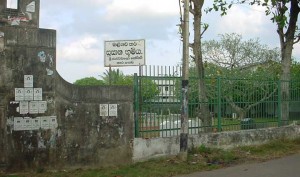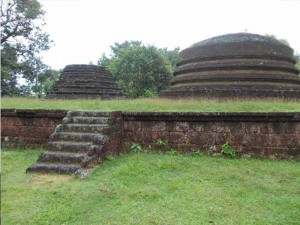Sri Jayawardhana Pura Kotte, is without an iota of doubt a thriving place to build businesses and a highly coveted residential neighborhood of 21st century Sri Lanka. However, many of the locals are certainly unaware of the rich and proud past of this rapidly growing metropolitan area, which has through the years undergone innumerable changes.
Kotte was an impregnable fortress founded by minister Alakeshwara during the reign of King Vikramabahu III (1357-74) who built the city to oust the invasions from South India and China. It was King Parakramabahu VI who built the sumptuous Royal palace, and as a tradition the tooth relic of Lord Buddha was held under the aegis of this five storey “Pas Mal Peya”. After the completion of the three storey temple of tooth, the ‘dalada’ was later transferred to the new site which was found in the vicinity of the Royal palace. The land on which the Dalada Maligawa stood is the present Kotte cemetery (Karakoppuwa).
The palace was encompassed by its own fashionable landscaped gardens, known as “Pas mal peya watta” with two mounds large and strewed with bricks, and had special tanks installed known as “pokuna” which reached all the way to “Pita Kotte” meaning outer fortress. There was several water bodies found in the city of Kotte, many of which have dried up and no longer to be seen. The palace was destroyed after the Portuguese seized control of the region, and the rubble and bricks from the palace grounds were carried away by the Dutch and the British for the construction of churches and to build the breakwater at Galle face. The valuables were looted, and as of today, there remains no monumental testimony except the name of the street “Maligawa road” all that is left of the much admired palace. Based on the books authored by Colonial powers, the palace was torn down to make way for the construction of a Church and its cemetery, all being replaced by modern structures and not a stone of it is visible today.
The Gal Ambalama in Pitta Kotte which dates back to the reign of King Parakramabahu VI is a 20feet long and 15 feet wide doss house that rests on ten granite pillars. Despite its turbulent history, the structure remains intact and continues to serve the locals as a resting and waiting abode. The secret passages (tunnels) built with laterite by Alakeshwara can be found in Ananda Sastralaya, a stones throw from the original Amabalama Pita Kotte. The minister built two secret tunnels connecting the Royal palace to Pitta Kotte, one had been a small subterranean passage with a width wide enough for people to walk one behind the other while the other, was broad and high enough for a horseman to ride through. Another tunnel was built to rescue Vidiya Bandara, consort of Princess Samudradevi who employed those of “Pallaru” caste to rescue him from the clutches of the Portuguese. Vidiya Bandara escaped with the help of the Franciscan friars who had their monastery near Queen’s House in Colombo (President’s house). Behind the Kotte Rajamaha Vihara one could find the entrance to another secret passage, which was used by the Queens in the days of yore to visit the temple from the Palace.
The oversight of the Lankan society has through the years, gradually destroyed the monumental remnants of the Kingdom of Kotte. If there is no proper awareness and conservation, the handful of precious historic sites that is left today will soon be lost forever. It is definitely a duty vested upon those residing in the territory of the former Kingdom, to help conserve the heritage buildings and secure it for posterity.






















